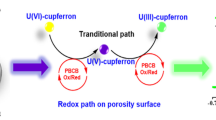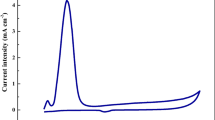Abstract
Intake of water contaminated with lead (Pb2+) and mercury (Hg2+) ions leads to various toxic effects and health issues. In this context, an amperometric urease inhibition-based biosensor was developed to detect Pb2+ and Hg2+ ions in water matrix. The modified Pt/CeO2/urease electrode was fabricated by immobilizing CeO2 nanoparticles and urease using a semi-permeable adsorption layer of nafion. With urea as a substrate, urease catalytic activity was examined through cyclic voltammetry. Further, maximum amperometric inhibitive response of the modified Pt/CeO2/urease electrode was observed in the presence of Pb2+ and Hg2+ ions due to the urease inhibition at specific potentials of −0.03 and 0 V, respectively. The developed sensor exhibited a detection limit of 0.019 ± 0.001 μM with a sensitivity of 89.2 × 10−3 μA μM−1 for Pb2+ ions. A detection limit of 0.018 ± 0.003 with a sensitivity of 94.1 × 10−3 μA μM−1 was achieved in detecting Hg2+ ions. The developed biosensor showed a fast response time (<1 s) with a linear range of 0.5–2.2 and 0.02–0.8 μM for Pb2+ and Hg2+ ions, respectively. The modified electrode offered a good stability for 20 days with a good repeatability and reproducibility. The developed sensor was used to detect Pb2+ and Hg2+ ions contaminating Cauvery river water and the observed results were in good co-ordination with atomic absorption spectroscopic data.




Similar content being viewed by others
References
Du N, Chen M, Liu Z, Sheng L, Xu H, Chen S. Kinetics and mechanism of jack bean urease inhibition by Hg2+. Chem Cent J. 2012;6:154. doi:10.1186/1752-153X-6-154.
Mohammadi H, Amine A, Cosnier S, Mousty C. Mercury–enzyme inhibition assays with an amperometric sucrose biosensor based on a trienzymatic-clay matrix. Anal Chim Acta. 2005;543:143–9. doi:10.1016/j.aca.2005.04.014.
Aragay G, Merkoci A. Nanomaterials application in electrochemical detection of heavy metals. Electrochim Acta. 2012;84:49–61. doi:10.1016/j.electacta.2012.04.044.
Flora SJS, Mittal M, Mehta A. Heavy metal induced oxidative stress & its possible reversal by chelation therapy. Indian J Med Res. 2008;128:501–23.
Li F, Wang J, Lai Y, Wu C, Sun S, He Y, Ma H. Ultrasensitive and selective detection of copper (II) and mercury (II) ions by dye-coded silver nanoparticle-based SERS probes. Biosens Bioelectron. 2013;39:82–7. doi:10.1016/j.bios.2012.06.050.
March G, Nguyen T, Piro B. Modified electrodes used for electrochemical detection of metal ions in environmental analysis. Biosensors. 2015;5:241–75. doi:10.3390/bios5020241.
Chauhan N, Pundir CS. An amperometric biosensor based on acetylcholinesterase immobilized onto iron oxide nanoparticles/multi-walled carbon nanotubes modified gold electrode for measurement of organophosphorus insecticides. Anal Chim Acta. 2011;701:66–74. doi:10.1016/j.aca.2011.06.014.
Ganjali MR, Motakef-Kazami N, Faridbod F, Khoee S, Norouzi P. Determination of Pb2+ ions by a modified carbon paste electrode based on multi-walled carbon nanotubes (MWCNTs) and nanosilica. J Hazard Mater. 2010;173:415–9. doi:10.1016/j.jhazmat.2009.08.101.
Adrrienne SE, Anne GW (2010) Guidelines for the identification and management of lead exposure in pregnant and lactating women.
Selvanayagam AS, Jeyaprakash BG, Rayappan JBB. Preparation, characterization and chemical sensing properties of polyaniline thin films. J Appl Sci. 2012;12:1710–3.
Liu C, Bai R, San Ly Q. Selective removal of copper and lead ions by diethylenetriamine-functionalized adsorbent: behaviors and mechanisms. Water Res. 2008;42:1511–22. doi:10.1016/j.watres.2007.10.031.
Gumpu MB, Sethuraman S, Krishnan UM, Rayappan JBB. A review on detection of heavy metal ions in water—an electrochemical approach. Sensors Actuators B Chem. 2015;213:515–33. doi:10.1016/j.snb.2015.02.122.
Prabhakaran D, Yuehong M, Nanjo H, Matsunaga H. Naked-eye cadmium sensor: using chromoionophore arrays of Langmuir-Blodgett molecular assemblies. Anal Chem. 2007;79:4056–65. doi:10.1021/ac0623540.
Narin I, Soylak M, Elçi L, Doğan M. Determination of trace metal ions by AAS in natural water samples after preconcentration of pyrocatechol violet complexes on an activated carbon column. Talanta. 2000;52:1041–6.
Pobozy E, Halko R, Krasowski M, Wierzbicki T, Trojanowicz M. Flow-injection sample preconcentration for ion-pair chromatography of trace metals in waters. Water Res. 2003;37:2019–26. doi:10.1016/S0043-1354(02)00615-2.
Gumpu MB, Nesakumar N, Sethuraman S, Krishnan UM, Rayappan JBB. Development of electrochemical biosensor with ceria–PANI core–shell nano-interface for the detection of histamine. Sensors Actuators B Chem. 2014;199:330–8. doi:10.1016/j.snb.2014.04.009.
Date Y, Terakado S, Sasaki K, Aota A, Matsumoto N, Shiku H, Ino K, Watanabe Y, Matsue T, Ohmura N. Microfluidic heavy metal immunoassay based on absorbance measurement. Biosens Bioelectron. 2012;33:106–12. doi:10.1016/j.bios.2011.12.030.
Nesakumar N, Sethuraman S, Krishnan UM, Rayappan JBB. Fabrication of lactate biosensor based on lactate dehydrogenase immobilized on cerium oxide nanoparticles. J Colloid Interface Sci. 2013;410:158–64. doi:10.1016/j.jcis.2013.08.009.
Zhuang J, Fu L, Tang D, Xu M, Chen G, Yang H. Target-induced structure-switching DNA hairpins for sensitive electrochemical monitoring of mercury (II). Biosens Bioelectron. 2013;39:315–9. doi:10.1016/j.bios.2012.07.015.
Wang Z, Qin Y, Wang C, Sun L, Lu X, Lu X. Preparation of electrochemical sensor for lead(II) based on molecularly imprinted film. Appl Surf Sci. 2012;258:2017–21. doi:10.1016/j.apsusc.2011.05.005.
Singh M, Nesakumar N, Sethuraman S, Maheswari U. Electrochemical biosensor with ceria—polyaniline core shell nano-interface for the detection of carbonic acid in blood. J Colloid Interface Sci. 2014;425:52–8. doi:10.1016/j.jcis.2014.03.041.
Simm AO, Banks CE, Wilkins SJ, Karousos NG, Davis J, Compton RG. A comparison of different types of gold-carbon composite electrode for detection of arsenic(III). Anal Bioanal Chem. 2005;381:979–85. doi:10.1007/s00216-004-2960-z.
Ilangovan R, Daniel D, Krastanov A, Zachariah C, Elizabeth R. Enzyme based biosensor for heavy metal ions determination. Biotechnol Biotechnol Equip. 2014;20:184–9. doi:10.1080/13102818.2006.10817330.
Shen L, Chen Z, Li Y, He S, Xie S, Xu X, Liang Z, Meng X, Li Q, Zhu Z, Li M, Le XC, Shao Y. Electrochemical DNAzyme sensor for lead based on amplification of DNA-au bio-bar codes. Anal Chem. 2008;80:6323–8. doi:10.1021/ac800601y.
Bagal-Kestwal D, Karve MS, Kakade B, Pillai VK. Invertase inhibition based electrochemical sensor for the detection of heavy metal ions in aqueous system: application of ultra-microelectrode to enhance sucrose biosensor’s sensitivity. Biosens Bioelectron. 2008;24:657–64. doi:10.1016/j.bios.2008.06.027.
Chey CO, Ibupoto ZH, Khun K, Nur O, Willander M. Indirect determination of mercury ion by inhibition of a glucose biosensor based on ZnO nanorods. Sensors (Basel). 2012;12:15063–77. doi:10.3390/s121115063.
Soldatkin OO, Kucherenko IS, Pyeshkova VM, Kukla AL, Jaffrezic-Renault N, El’skayaa V, Dzyadevych SV, Soldatkin AP. Novel conductometric biosensor based on three-enzyme system for selective determination of heavy metal ions. Bioelectrochemistry. 2012;83:25–30. doi:10.1016/j.bioelechem.2011.08.001.
Upadhyay LSB. Urease inhibitors: a review. Indian J Biotechnol. 2012;11:381–8.
Guascito MR, Malitesta C, Mazzotta E, Turco A. Inhibitive determination of metal ions by an amperometric glucose oxidase biosensor. Sensors Actuators B Chem. 2008;131:394–402. doi:10.1016/j.snb.2007.11.049.
Solanki PR, Kaushik A, Agrawal VV, Malhotra BD. Nanostructured metal oxide-based biosensors. NPG Asia Mater. 2011;3:17–24. doi:10.1038/asiamat.2010.137.
Benini S, Rypniewski WR, Wilson KS, Miletti S, Ciurli S, Mangani S. A new proposal for urease mechanism based on the crystal structures of the native and inhibited enzyme from Bacillus pasteurii: why urea hydrolysis costs two nickels. Structure. 1999;7:205–16. doi:10.1016/S0969-2126(99)80026-4.
Ciurli S, Benini S, Rypniewski WR, Wilson KS, Miletti S, Mangani S. Structural properties of the nickel ions in urease: novel insights into the catalytic and inhibition mechanisms. Coord Chem Rev. 1999;190–192:331–55. doi:10.1016/S0010-8545(99)00093-4.
Begum A, Ramaiah M, Harikrishna KI, Veena K. Heavy metal pollution and chemical profile of Cauvery River water. E-Journal Chem. 2009;6:47–52. doi:10.1155/2009/154610.
Jameel AA, Sirajudeen J, Abdul R. Studies on heavy metal pollution of ground water sources between Tamilnadu and Pondicherry, India. Adv Appl Sci Res. 2012;3:424–9.
Bui MPN, Li CA, Han KN, Pham XH, Seong GH. Electrochemical determination of cadmium and lead on pristine single-walled carbon nanotube electrodes. Anal Sci. 2012;28:699–704.
Li Y, Liu XR, Ning XH, Huang CC, Zheng JB, Zhang JC. An ionic liquid supported CeO2 nanoparticles–carbon nanotubes composite-enhanced electrochemical DNA-based sensor for the detection of Pb2+. J Pharm Anal. 2011;1:258–63. doi:10.1016/j.jpha.2011.09.001.
Hwang GH, Han WK, Park JS, Kang S-G. An electrochemical sensor based on the reduction of screen-printed bismuth oxide for the determination of trace lead and cadmium. Sensors Actuators B Chem. 2008;135:309–16. doi:10.1016/j.snb.2008.08.039.
Wang Z, Wang H, Zhang Z, Liu G. Electrochemical determination of lead and cadmium in rice by a disposable bismuth/electrochemically reduced graphene/ionic liquid composite modified screen-printed electrode. Sensors Actuators B Chem. 2014;199:7–14. doi:10.1016/j.snb.2014.03.092.
Yusof NA, Daud N, Zareena S, Saat M, Tee TW. Electrochemical characterization of carbon nanotubes / nafion / aspartic acid modified screen printed electrode in development of sensor for determination of Pb(II). Int J Electrochem Sci. 2012;7:10358–64.
Huang MR, Ding YB, Li XG. Combinatorial screening of potentiometric Pb(II) sensors from polysulfoaminoanthraquinone solid ionophore. ACS Comb Sci. 2014;16:128–38. doi:10.1021/co400140g.
Domínguez-Renedo O, Alonso-Lomillo MA, Ferreira-Gonçalves L, Arcos-Martínez MJ. Development of urease based amperometric biosensors for the inhibitive determination of Hg (II). Talanta. 2009;79:1306–10. doi:10.1016/j.talanta.2009.05.043.
Acknowledgements
The authors are grateful to the Department of Science & Technology, New Delhi for their financial support (DST/TM/WTI/2K14/197(a)(G)), (SR/FST/ETI-284/2011 (C)), (SR/FST/LSI-453/2010) and (SR/NM/PG-16/2007). We also acknowledge SASTRA University, Thanjavur for extending infrastructure support to carry out the study.
Author information
Authors and Affiliations
Corresponding author
Ethics declarations
Conflict of interest
The authors declare that they have no conflict of interest.
Electronic supplementary material
ESM 1
(PDF 1.17 MB)
Rights and permissions
About this article
Cite this article
Gumpu, M.B., Krishnan, U.M. & Rayappan, J.B.B. Design and development of amperometric biosensor for the detection of lead and mercury ions in water matrix—a permeability approach. Anal Bioanal Chem 409, 4257–4266 (2017). https://doi.org/10.1007/s00216-017-0376-9
Received:
Revised:
Accepted:
Published:
Issue Date:
DOI: https://doi.org/10.1007/s00216-017-0376-9




